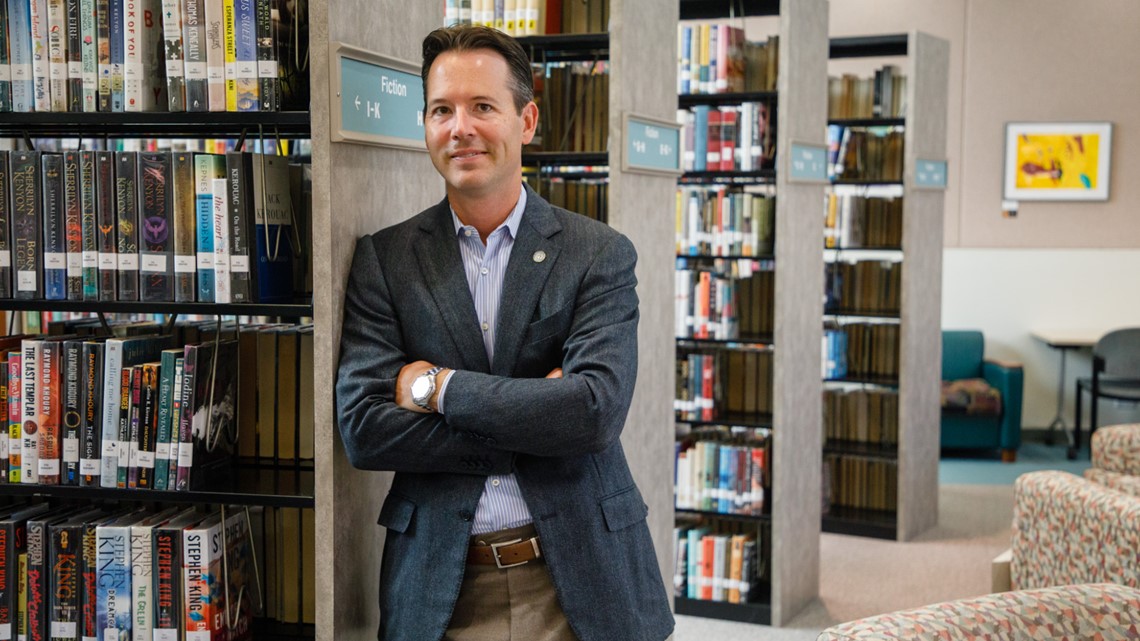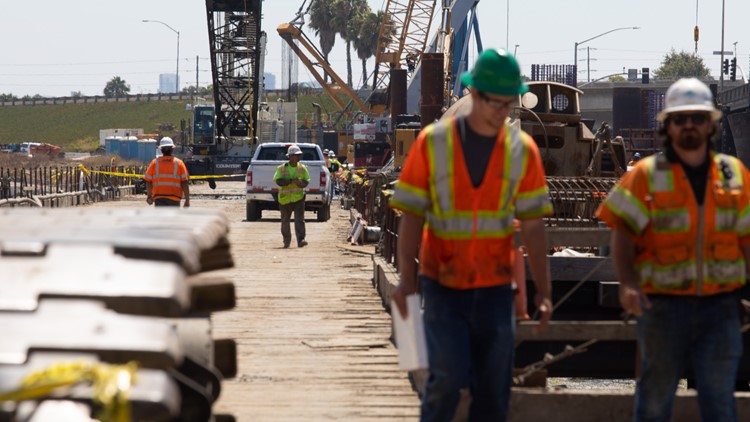SAN DIEGO — Three years after San Diego voters overwhelmingly approved a ballot measure to boost money to fix roads, sidewalks and storm drains, funding is falling far short of projections and is expected to run out by the summer of 2022.
When voters approved the Rebuild San Diego measure by a 30-point margin in June 2016, they did it on promises from Mayor Kevin Faulconer, City Councilman Mark Kersey and business groups that $3 billion to $4 billion in expected revenue growth and pension cost savings would fund infrastructure improvements over the next 25 years. It doesn’t look like that will happen.
City budget documents reviewed by inewsource show that so far just $59 million has been allocated. To hit $4 billion, the annual revenue would need to average $160 million.
How the revenues missed the mark so badly can be explained by how the ballot measure was crafted.
Notably, Rebuild San Diego was not a tax increase. Instead, it directs city officials to use three pots of funding from existing sources for infrastructure projects. Here’s how the calculations work for each pot:
For the first five years, 50% of growth from one year to the next in property taxes, hotel room taxes and franchise fees. After that, this pot goes away.
Annual growth in sales tax revenue, compared to 2016 revenues adjusted for changes in the California Consumer Price Index.
All cash savings from reduced payments to the city’s pension fund, using fiscal 2016 as the baseline.
So far, only the property tax pot has produced any money, and that isn’t likely to change in the near future or maybe ever.
A five-year financial outlook report published by the city’s Finance Department last year shows no available funding beyond fiscal 2022.
Scott Barnett, president of San Diego Taxpayers Advocate, opposed the measure — officially called Proposition H. In his view, the shortfalls should concern voters.


“If it was only gonna be for five years, then what's the point? I mean, that's like budget dust in the scheme of things,” Barnett said. “It’s just not that much money.”
Kersey, who is considering a run for mayor in 2020, led the campaign to get Rebuild San Diego on the ballot. He acknowledged that funding is down but said he still views the ballot measure as a success.
“It’s just putting a dent in the overall billion dollar plus problem, but it is real money,” he said, adding later, “Obviously, the economy shifts, and that’s just the way that the market forces play out.”
The consequences for the city’s future are hard to calculate — in part because the measure was passed with no specific project list or independent oversight.
But the city has a nearly $2 billion infrastructure funding deficit and faces significant needs: Many city structures are aging, roads are in bad shape, tens of thousands of sidewalks need replacing, and treasured buildings in Balboa Park require major structural repairs.
How Rebuild San Diego fell short
Voters weren’t just promised 25 years of infrastructure funding that may never happen. The projections for the early years of Rebuild San Diego also were off significantly.
The fiscal impact statement in the voter guide gave a five-year estimate that “between $140 million and $200 million in future revenues could be allocated” to a new dedicated infrastructure fund if voters approved the measure.
Even at the lowest end of those voter guide estimates, Rebuild San Diego is trending tens of millions of dollars short.
“We were a little off on our projections,” said Jillian Kissee, a fiscal and policy analyst for the city’s Independent Budget Analyst’s Office.
That office created the estimate, which was also signed off on by the offices of the chief financial officer and auditor.
Kissee said the main reason for the faulty estimate is San Diego’s sales tax revenues have fallen below projections. That’s due to higher inflation rates than predicted in 2016 and a shift to online sales, she said.
“I think it was just a function of not knowing the future, not having the actual numbers in front of us,” Kissee said.
The city’s sales tax revenues trended upward from 2010, with a high point of $275.7 million in fiscal 2016. Since then, revenues have dipped slightly. For example, they were down about 1% in fiscal 2018 from the baseline year set in the ballot measure. That’s why this pot of funding hasn’t materialized.
Sales tax revenues may grow and help fund Rebuild San Diego projects in the future, Kissee said, but cuts in the city’s pension costs aren’t expected anytime soon. She points out that her office did accurately predict in 2016 there wouldn’t be pension savings money available for Rebuild San Diego.
San Diego’s pension funding woes are legendary, beginning with decisions by city councils in 1996 and 2002 to underfund the retirement system. In the mid-2000s, those decisions and others led to talk of the city possibly having to declare bankruptcy.
Though that didn’t happen, city leaders attempted to fix the system with a 2012 ballot measure that put most new city employees, except for police officers, in a 401(k)-style retirement system. The state Supreme Court last year ruled against how that was done, creating more economic challenges for the city.
Through all of this, the pension deficit has grown to nearly $3 billion, and the city will have to make an annual $350.5 million payment to the retirement fund this fiscal year. That was due in part to pension plan officials lowering expected returns from the system’s investments.
Some of this could not have been predicted when revenue projections for Rebuild San Diego were being made, Kersey said.
“A lot of those dollars were based on the information at the time of what the city's pension liability was, when it was going to get paid down and then how much money was going to get freed up as a result,” he said.
“The pension system and the terrible decisions made 18, 19 years ago continue to haunt us,” he added.
But some of Rebuild San Diego’s critics believe the ballot measure was troubled from the get-go.


“This was a measure that could look like it was a big deal,” said Kyra Greene, executive director of the Center on Policy Initiatives, a San Diego nonprofit that opposed the proposition in 2016. “But once you dug down into the details, which we noted at the time, there was no way that this would be that big solution that we were looking for.”
In Greene’s view, the promise made to voters of up to $4 billion in revenue was unachievable.
“It was based on mythical thinking about some of these sources of revenue, especially the savings around pensions,” she said.
Rebuild San Diego made it on the ballot in part because of its high-profile supporters, including former Mayor Jerry Sanders, now head of the San Diego Regional Chamber of Commerce.
The chamber’s PAC gave a combined $42,000 in support of the ballot measure, the largest contributor to the campaign. Many of the financial backers also had building and construction ties.
Overall, about $260,000 was spent backing Rebuild San Diego. Zero was spent opposing it.
How Rebuild San Diego money has been spent
Of the $59 million in revenues allocated so far under Rebuild San Diego, more than $25 million has been spent or set aside for road repairs. That includes slurry seal maintenance and reconstruction work. More than $9 million has gone toward sidewalk improvements.
This fiscal year, $1.8 million will be spent on Americans with Disabilities Act improvements at Egger/South Bay Community Park and Olive Grove Community Park. Ingraham Street in the Mission Bay area will get $300,000 for new street lights. Construction is also underway for $345,000 in security lighting at parks.
Larger projects that received some Rebuild San Diego funds include the replacement of the West Mission Bay Drive bridge near SeaWorld. The bridge dates to the early 1950s.
The work will create six lanes of traffic across side-by-side bridges. Currently there are four lanes. Caltrans found the existing bridge functionally obsolete because traffic volume exceeds its capacity.


Another project benefiting from Rebuild San Diego money: the interchange at state Route 94 and Euclid Avenue, a high traffic area in need of safety improvements. The project will add traffic signals and increase capacity. The ballot measure is providing $244,000 toward the work.
Tracking the exact impact of the funding is challenging. Rebuild San Diego has delivered on some repairs and projects — but on a much smaller financial scale than Kersey and backers pitched to voters.
This fiscal year, funds from the ballot measure make up just 3.4% of the city’s nearly $711 million capital improvement program. The program is the city’s master plan for construction projects that provide improvements or additions to things such as buildings, bridges, sidewalks and streets.
The Rebuild San Diego project list published annually in the city budget also lacks details, and city officials said funding is sometimes shifted as projects are completed or schedules changed.
It took the Mayor’s Office nearly two weeks to provide inewsource with a detailed list of projects and current spending under Rebuild San Diego.
Rebuild San Diego Projects
To read a list of projects that have or are being funded by Rebuild San Diego revenues, click here.
Plus, tracking results is complicated because some Rebuild San Diego repairs, such as slurry sealing for streets, are merged with funding from other areas of the city’s budget. The city fixes more than 300 miles of streets annually, Ashley Bailey, a spokeswoman for the Mayor’s Office, said in an email.
“It’s difficult to determine which specific streets of those 300-plus” were directly from the ballot measure, Bailey said, because all “street funds are commingled.”
What happens next for Rebuild San Diego
As for Rebuild San Diego’s future, Kersey said it’s too early to predict what steps will be necessary. The city faces a $1.86 billion backlog of infrastructure work that he said has been accumulating for more than 50 years.
“Maybe we go back to the voters with a followup measure at some point in the future,” Kersey said, adding that future city councils and mayors could also simply choose to “do the right thing” and include enough funding for infrastructure projects in yearly budgets.


Sean Karafin, the chamber’s vice president of public policy and economic research, said he expects sales tax revenues and pension savings will eventually increase and be a substantial contributor to the ballot measure’s fund.
“I think it's working as it's supposed to be working,” Karafin said. “I think the major success is designed to come in the later years.”
The backdrop for this debate over whether Rebuild San Diego has lived up to its promise to voters is the March 2020 election, when Kersey may be running for mayor and a likely San Diego Convention Center ballot measure will include potential infrastructure funding.
The ballot measure, called “For A Better San Diego,” would raise the city’s hotel room tax to as high as 15.75% to pay to expand the convention center, with a smaller share of revenue going for homeless programs and infrastructure.
The City Council voted 5-4 to move forward with putting the measure on the ballot. Kersey supported the measure.
If voters approve the measure, money for streets wouldn’t be available until fiscal 2025. By then, funding from Rebuild San Diego will likely have run out — unless sales taxes and pension savings finally start producing revenue for infrastructure.



